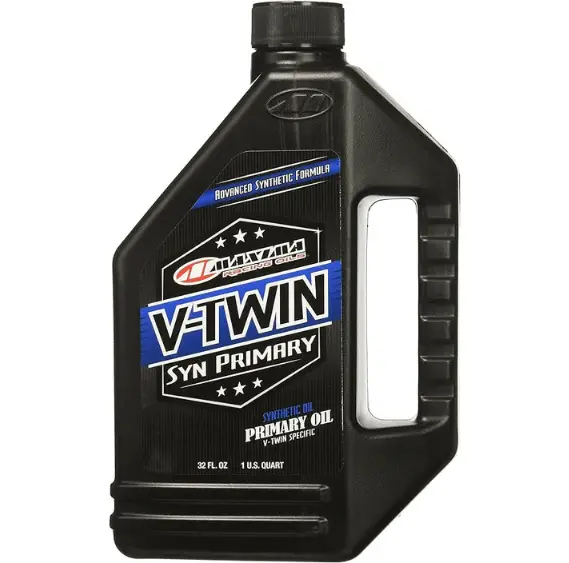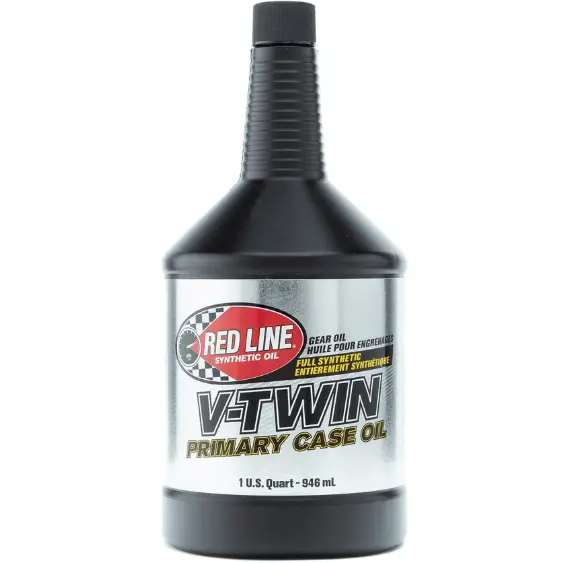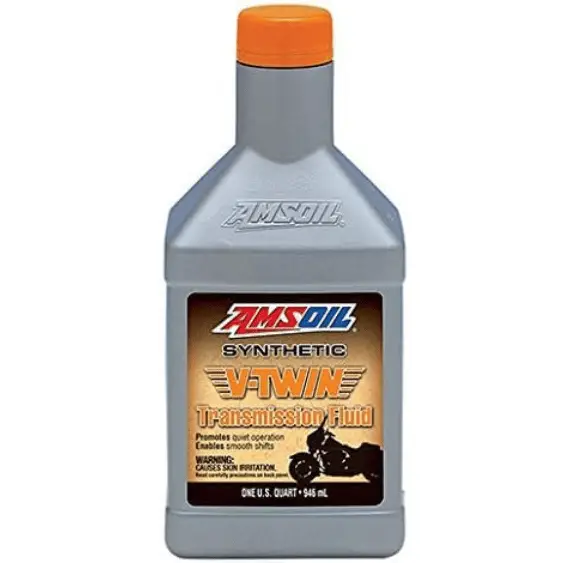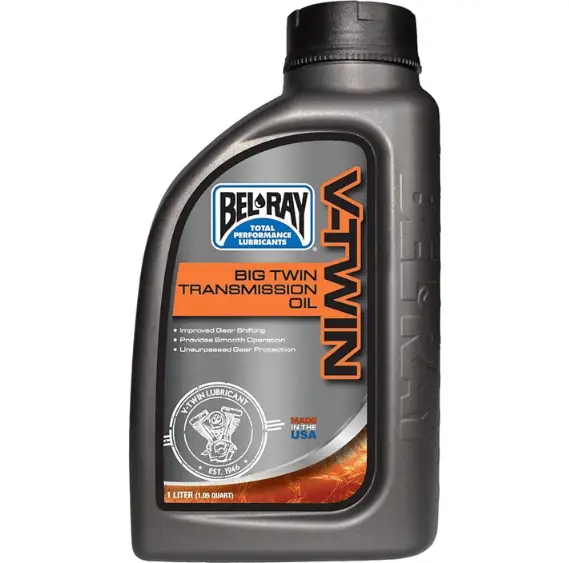Imagine cruising down the open road, the rumble of your Harley’s engine in sync with the heartbeat of the highway. The last thing you want is transmission trouble to disrupt your ride. To keep your Harley running smoothly, it’s essential to choose the right oil for your transmission and primary. Picking the perfect potion for your bike not only ensures a seamless gear shift but also extends the life of your motorcycle’s moving parts. Let’s gear up and find out the best oil for Harley transmission and primary configurations of all types, to keep you riding without a hitch. Ready? Let’s keep moving! I’ll leave my favorite pick down below, and an option to skip to the full reviews, or you can use the navigation glossary below.
- Red Line Primary Oil Review
- Amsoil Transmission Fluid Review
- Maxima Primary Oil
- Bel-Ray Big Twin Primary Oil and Transmission Fluid
- Chase’s Pick

Maxima’s V-Twin Full Synthetic Primary Oil
From the time I spent in motorcycle shops, I saw Maxima’s products everywhere. Oddly enough, I don’t see the brand discussed as often but was constantly reminded of their quality throughout my time at the shop. I encourage you to go ahead and check it out, or skip to my full review of the product with the “read Review” button below. Cheers!
Understanding Harley Transmission and Primary System
If you own a Harley-Davidson motorcycle, you’re probably intimately familiar with that distinctive rumble and the sense of freedom that comes with it—freedom that depends on a well-maintained bike. An integral aspect of keeping your Harley in top shape is understanding its transmission and primary system, and particularly, the oils that keep them running smoothly.
Functions of Transmission Oil
Your Harley’s transmission oil has several crucial jobs. It lubricates the gears, bearings, and other moving parts within the transmission, reducing friction and preventing wear and tear. It also helps to dissipate the heat generated by the mechanical action inside the transmission, aiding in keeping everything at an optimal temperature. Good transmission oil ensures a smoother ride since it allows for seamless gear shifting.
Role of Primary Oil in Lubrication
Primary oil, on the other hand, lubricates the primary chain, clutch, and the gear system that transmits power from your engine to the transmission. This oil serves to reduce the friction among these components, promoting efficient power transfer and lengthening their lifespan. It’s especially important for the clutch, as it prevents sticking and slipping, ensuring that you can engage and disengage the engine without any fuss.
Differences Between Transmission and Primary Lubrication
One key thing to keep in mind is that the lubrication needs of the transmission and primary systems are not identical. Transmission oil must be resilient against pressure and heat to protect high-speed moving parts. Primary oil, however, should be adept not only at lubricating but also at enabling the clutch to engage properly. This difference is why most Harley models use separate oils for each of these systems, tailored to their specific requirements.
Types of Oils Suitable for Harley Transmission and Primary
When it comes to oils, not all are created equal. There are several types to consider for your Harley’s transmission and primary.
Mineral Oils
Mineral oils are the traditional choice and are derived directly from refined crude oil. They are generally more affordable and are a good choice if you stick to regular change intervals since they don’t last as long as synthetic options. They provide a basic level of protection and are better suited for older bikes or those with less demanding performance requirements.
Semi-Synthetic Oils
Semi-synthetic oils are a blend of mineral and synthetic oils. They offer improved performance and protection compared to straight mineral oils. This is a middle-of-the-road option for those who want some of the benefits of synthetic oils without the higher cost.
Full Synthetic Oils
Full synthetic oils are engineered to provide superior performance in all aspects, from reducing wear to enhancing heat dissipation. They’re the best option for high-performance bikes or for riders who demand the most from their Harleys. Full synthetic oils last longer and protect better under extreme conditions, though they come at a higher price.
Specialty Motorcycle Oils
Specialty motorcycle oils are formulated with the unique needs of motorcycles in mind. They can be any of the above types—mineral, semi-synthetic, or full synthetic—but with additives and formulary tweaks designed for motorcycle engines and transmissions, which often share oil, unlike cars.
Popular Brands of Oil for Harley-Davidson Motorcycles
When it comes to choosing an oil brand for your Harley, consider these respected options.

RedLine Primary and Transmission Oil
Key Features
- High-performance synthetic oil.
- Respected in the motorcycle community for quality and efficacy.
- Popular choice among Harley riders.
RedLine offers high-performance synthetic oils that are respected in the motorcycle community for their quality and efficacy, making them a popular choice among Harley riders.
Switching to RedLine for my Harley’s transmission and primary oil was a decision I’ll never regret. The difference in performance was apparent from the first ride. The gears shifted smoother, and the engine ran cooler, even on longer rides. What sets RedLine apart for me is how it maintains its performance over time, a real testament to its quality. I used to think all oils were the same, but RedLine changed my mind. For any Harley owner looking to enhance their bike’s performance, I highly recommend checking RedLine out on Amazon. Their positive reviews are well-earned, and my experience aligns perfectly with them.
Community Feedback

AMSOIL Synthetic Transmission Fluid
Key Features
- Top-tier synthetic motorcycle oil and transmission fluid.
- Delivers exceptional performance and long-lasting protection.
- Suited for Harley’s engine and transmission.
AMSOIL has a reputation for producing top-tier synthetic motorcycle oils and transmission fluids that deliver great performance and long-lasting protection for your Harley’s engine and transmission.
After switching to AMSOIL Synthetic Transmission Fluid, I noticed a significant improvement in my Harley’s performance. This oil has given my bike a new lease of life, especially in terms of gear shifts and overall engine efficiency. Riding in different weather conditions, I’ve seen how AMSOIL copes admirably, maintaining a consistent performance. If you’re on the fence about trying a new transmission fluid, I’d suggest giving AMSOIL a shot. It’s a decision you won’t regret, and you can see for yourself on Amazon where many others share my positive experiences.
Community Feedback

Maxima V-Twin Synthetic Primary Oil
Key Features
- Specifically formulated for V-Twin engines.
- Offers excellent wear protection and thermal stability.
- Recommended by insiders and experienced motorcycle shops.
Maxima is another giant in the synthetic oil market, known for providing excellent wear protection and thermal stability, specifically formulated for V-Twin engines like those found in Harleys. Not as known as more popular brands, Maxima is typically found in experienced motorcycle shops recommended by insider’s in the industry (in my experience).
I was recommended Maxima V-Twin Synthetic Primary Oil by a fellow Harley rider and decided to give it a try. The improvement in my bike’s performance was noticeable right from the first use. The engine runs smoother, and the heat resistance is remarkable. I particularly appreciate how it’s tailored for V-Twin engines, giving me confidence that my Harley is getting the best care. For those looking to try something beyond the mainstream brands, Maxima is a great choice. I found some insightful reviews on Amazon that echo my own positive experience with this oil.
Community Feedback

Bel-Ray V-Twin Transmission Oil
Key Features
- Specialized transmission oil for V-Twin engines.
- Provides superior film strength.
- Protects against wear and temperature extremes.
Bel-Ray provides specialized transmission oil for V-Twin engines, offering superior film strength and protecting against wear and temperature extremes.
I decided to try Bel-Ray V-Twin Transmission Oil based on some online recommendations, and I wasn’t disappointed. The way my Harley runs now is noticeably smoother, especially in terms of transmission performance. I’ve ridden in some extreme conditions, and Bel-Ray has consistently protected my bike’s transmission, which is crucial for me. For Harley owners who are particular about their bike’s maintenance, Bel-Ray is a brand worth considering. You can find a lot of fellow riders sharing their positive experiences on Amazon, and I’m glad to add my own to that list.
Community Feedback
How to Choose the Best Oil for Your Harley (Buyer’s Guide)
Now that you understand your options, how do you pick the best one? Here’s a guide.
Assessing Your Riding Style
Think about how you ride. Do you push your bike to the limits, go for long rides often, or stick to short commutes? Different styles and uses will demand different properties from your oil.
Understanding Your Harley Model’s Requirements
Make sure to match the oil with your specific Harley model’s recommendation. Using the wrong oil can lead to suboptimal performance and even damage.
Environmental Considerations
Consider the typical riding conditions and climate you encounter. You’ll need an oil that can handle those environmental stresses well.
Compatibility With Clutch Materials
Some oils are not suitable for the clutch materials in your Harley. Check that the oil you choose is compatible, as the wrong type could lead to clutch slippage or other issues.
Budget and Cost-Effectiveness
While you may not want to go for the cheapest option, it’s worthwhile to consider the cost-effectiveness of the oil you choose. High-quality synthetic oils may be more expensive upfront but could save money in the long run due to their longevity.
Characteristics To Look for In High-Quality Motorcycle Oils
A high-quality motorcycle oil will tick several important boxes.
Viscosity Ratings
The viscosity rating of oil, denoted by numbers like 10W-40, indicates how it flows at different temperatures. A good motorcycle oil must maintain its viscosity across the range of temperatures it’s exposed to.
Thermal Stability
An oil with good thermal stability will resist breaking down at high temperatures, keeping your Harley’s systems protected even on the hottest days or during operation under high load.
Wear Protection
Look for oils that specifically state they offer wear protection. These have additives that form protective barriers on the metal surfaces to reduce contact and, hence, wear.
Corrosion Inhibition
Corrosion inhibitors in the oil will help protect the metal parts of your Harley’s engine and transmission systems from the deleterious effects of oxidation and corrosion.
Additives and Their Benefits
Additives such as detergents, dispersants, and anti-foaming agents also play key roles. They keep the engine clean, hold particulate matter in suspension, and prevent the oil from aerating, respectively, which ensures smooth operation.
Pros and Cons of Blended Oils for Harley Transmissions
Blended oils are often seen as a compromise, but what does that really mean for you and your Harley?
Advantages of Blended Oils
Blended oils offer improved performance over mineral oils at a more accessible price point than full synthetics. They might be just right for the average rider who wants a balance between cost and benefits.
Disadvantages of Blended Oils
However, they may not offer the same level of performance and protection as full synthetic oils, particularly under extreme conditions.
Comparing Blends to Full Synthetic and Mineral Oils
Consider that while full synthetics provide peak performance and endurance, they come with a higher price tag. Mineral oils, while budget-friendly, fall short on protection and longevity when compared to blends and full synthetics.